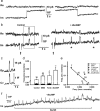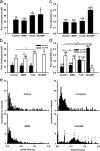cAMP-mediated stabilization of fusion pores in cultured rat pituitary lactotrophs
- PMID: 23637196
- PMCID: PMC3674111
- DOI: 10.1523/JNEUROSCI.5351-12.2013
cAMP-mediated stabilization of fusion pores in cultured rat pituitary lactotrophs
Abstract
Regulated exocytosis mediates the release of hormones and transmitters. The last step of this process is represented by the merger between the vesicle and the plasma membranes, and the formation of a fusion pore. Once formed, the initially stable and narrow fusion pore may reversibly widen (transient exocytosis) or fully open (full-fusion exocytosis). Exocytosis is typically triggered by an elevation in cytosolic calcium activity. However, other second messengers, such as cAMP, have been reported to modulate secretion. The way in which cAMP influences the transitions between different fusion pore states remains unclear. Here, hormone release studies show that prolactin release from isolated rat lactotrophs stimulated by forskolin, an activator of adenylyl cyclases, and by membrane-permeable cAMP analog (dbcAMP), exhibit a biphasic concentration dependency. Although at lower concentrations (2-10 μm forskolin and 2.5-5 mm dbcAMP) these agents stimulate prolactin release, an inhibition is measured at higher concentrations (50 μm forskolin and 10-15 mm dbcAMP). By using high-resolution capacitance (Cm) measurements, we recorded discrete increases in Cm, which represent elementary exocytic events. An elevation of cAMP leaves the frequency of full-fusion events unchanged while increasing the frequency of transient events. These exhibited a wider fusion pore as measured by increased fusion pore conductance and a prolonged fusion pore dwell time. The probability of observing rhythmic reopening of transient fusion pores was elevated by dbcAMP. In conclusion, cAMP-mediated stabilization of wide fusion pores prevents vesicles from proceeding to the full-fusion stage of exocytosis, which hinders vesicle content discharge at high cAMP concentrations.
Figures






Similar articles
-
Aluminium-induced changes of fusion pore properties attenuate prolactin secretion in rat pituitary lactotrophs.Neuroscience. 2012 Jan 10;201:57-66. doi: 10.1016/j.neuroscience.2011.11.015. Epub 2011 Nov 15. Neuroscience. 2012. PMID: 22123165
-
Vesicle size determines unitary exocytic properties and their sensitivity to sphingosine.Mol Cell Endocrinol. 2013 Aug 25;376(1-2):136-47. doi: 10.1016/j.mce.2013.06.012. Epub 2013 Jun 18. Mol Cell Endocrinol. 2013. PMID: 23791846
-
Subnanometer fusion pores in spontaneous exocytosis of peptidergic vesicles.J Neurosci. 2007 Apr 25;27(17):4737-46. doi: 10.1523/JNEUROSCI.0351-07.2007. J Neurosci. 2007. PMID: 17460086 Free PMC article.
-
Ångstrom-size exocytotic fusion pore: Implications for pituitary hormone secretion.Mol Cell Endocrinol. 2018 Mar 5;463:65-71. doi: 10.1016/j.mce.2017.04.023. Epub 2017 Apr 27. Mol Cell Endocrinol. 2018. PMID: 28457949 Review.
-
Unproductive exocytosis.J Neurochem. 2016 Jun;137(6):880-9. doi: 10.1111/jnc.13561. Epub 2016 May 1. J Neurochem. 2016. PMID: 26841731 Review.
Cited by
-
Astroglial Mechanisms of Ketamine Action Include Reduced Mobility of Kir4.1-Carrying Vesicles.Neurochem Res. 2020 Jan;45(1):109-121. doi: 10.1007/s11064-019-02744-1. Epub 2019 Feb 22. Neurochem Res. 2020. PMID: 30793220 Review.
-
Excitable Astrocytes: Ca(2+)- and cAMP-Regulated Exocytosis.Neurochem Res. 2015 Dec;40(12):2414-24. doi: 10.1007/s11064-015-1545-x. Epub 2015 Mar 3. Neurochem Res. 2015. PMID: 25732760 Review.
-
Local electrostatic interactions determine the diameter of fusion pores.Channels (Austin). 2015;9(2):96-101. doi: 10.1080/19336950.2015.1007825. Channels (Austin). 2015. PMID: 25835258 Free PMC article.
-
PACAP and acetylcholine cause distinct Ca2+ signals and secretory responses in chromaffin cells.J Gen Physiol. 2023 Feb 6;155(2):e202213180. doi: 10.1085/jgp.202213180. Epub 2022 Dec 20. J Gen Physiol. 2023. PMID: 36538657 Free PMC article.
-
Modeling of glucose-induced cAMP oscillations in pancreatic β cells: cAMP rocks when metabolism rolls.Biophys J. 2015 Jul 21;109(2):439-49. doi: 10.1016/j.bpj.2015.06.024. Biophys J. 2015. PMID: 26200880 Free PMC article.
References
Publication types
MeSH terms
Substances
Grants and funding
LinkOut - more resources
Full Text Sources
Other Literature Sources
